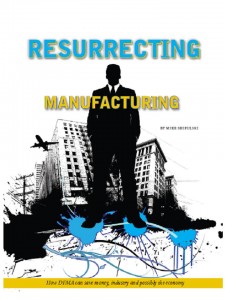Archive for the ‘Six Sigma’ Category
Seeing What Isn’t There
 It’s relatively straightforward to tell the difference between activities that are done well and those that are done poorly. Usually sub-par activities generate visual signals to warn us of their misbehavior. A bill isn’t paid, a legal document isn’t signed or the wrong parts are put in the box. Though the specifics vary with context, the problem child causes the work product to fall off the plate and make a mess on the floor.
It’s relatively straightforward to tell the difference between activities that are done well and those that are done poorly. Usually sub-par activities generate visual signals to warn us of their misbehavior. A bill isn’t paid, a legal document isn’t signed or the wrong parts are put in the box. Though the specifics vary with context, the problem child causes the work product to fall off the plate and make a mess on the floor.
We have tools to diagnose the fundamental behind the symptom. We can get to root cause. We know why the plate was dropped. We know how to define the corrective action and implement the control mechanism so it doesn’t happen again. We patch up the process and we’re up and running in no time. This works well when there’s a well-defined in place, when process is asked to do what it did last time, when the inputs are the same as last time and when the outputs are measured like they were last time.
However, this linear thinking works terribly when the context changes. When the old processes are asked to do new work, the work hits the floor like last time, but the reason it hits the floor is fundamentally different. This time, it’s not that an activity was done poorly. Rather, this time there’s something missing altogether. And this time our linear-thinker toolbox won’t cut it. Sure, we’ll try with all our Six Sigma might, but we won’t get to root cause. Six Sigma, lean and best practices can fix what’s broken, but none of them can see what isn’t there.
When the context changes radically, the work changes radically. New-to-company activities are required to get the new work done. New-to-industry tools are needed to create new value. And, sometimes, new-to-world thinking is the only thing that will do. The trick isn’t to define the new activity, choose the right new tool or come up with the new thinking. The trick is to recognize there’s something missing, to recognize there’s something not there, to recognize there’s a need for something new. Whether it’s an activity, a tool or new thinking, we’ve got to learn to see what’s not there.
Now the difficult part – how to recognize there’s something missing. You may think the challenging part is to figure out what’s needed to fill the void, but it isn’t. You can’t fill a hole until you see it as a hole. And once everyone agrees there’s a hole, it’s pretty easy to buy the shovels, truck in some dirt and get after it. But if don’t expect holes, you won’t see them. Sure, you’ll break your ankle, but you won’t see the hole for what it is.
If the work is new, look for what’s missing. If the problem is new, watch out for holes. If the customer is new, there will be holes. If the solution is new, there will be more holes.
When the work is new, you will twist your ankle. And when you do, grab the shovels and start to put in place what isn’t there.
Image credit – Tony Atler
Innovation isn’t a thing in itself.
 Innovation isn’t a thing in itself, and it’s not something to bolster for the sake of bolstering.
Innovation isn’t a thing in itself, and it’s not something to bolster for the sake of bolstering.
Innovation creates things (products, services, business models) that are novel, useful and successful. It’s important to know which flavor to go after, but before that it’s imperative to formalize the business objective. Like lean or Six Sigma, innovation is a business methodology whose sole intention is to deliver on the business objective. The business objective is usually a revenue or profit goal, and success is defined by meeting the objective. Successful is all about meeting the business objective and successful is all about execution.
There are a lot of things that must come together for an innovation to be successful. For an innovative product here are the questions to answer: Can you make it, certify it, market it, sell it, distribute it, service it, reclaim it? As it happens, these are the same questions to answer for any new product. In that way, innovative products are not different. But because innovation starts with novel, with innovative products the answers can be different. For an innovative product there are more “no’s” and for each no there’s a reason that starts with a C: constraint, capacity, capability, competitor, cooperation, capital. And the business objective cannot be achieved with closing the gaps.
After successful, there’s useful. Like any work based on a solid marketing methodology, innovation must deliver usefulness to the customer. Innovation or not, strong marketing is strong marketing and strong marketing defines who the customer is, how they’ll use the new service, and how they’ll benefit – the valuable customer outcome (VCO.) But with an innovative service it’s more difficult to know who the customer is, how they’ll use the service and if they’ll pay for it. (That’s the price of novelty.) But in most other ways, an innovative service is no different than any other service. Both are successful because they deliver usefulness customers, those customers pay money for the usefulness and the money surpasses the business objective.
Innovation is different because of novelty, but only in degree. Continuous improvement projects have novelty. Usually, it’s many small changes consistently applied that add up to meaningful results, for example waste reduction, improved throughput and product quality. These projects have novelty, but the novelty is the sum of small steps, all of which stay close to known territory.
The next rung on the novelty ladder is discontinuous improvement which creates a large step change in goodness provided to the customer. (Think 3X improvement.) The high degree of novelty creates broader uncertainty. Will the customer be able to realize the goodness? Will the novelty be appealing to a set of yet-to-be-discovered customers? Will they pay for it? It is worth doing all that execution work? Will it cannibalize other products? The novelty is a strong divergence from the familiar and with it comes the upside of new customer goodness and the downside of the uncertainty.
The highest form of novelty is no-to-yes. No other product on the planet could do it before, but the new innovative one can. It has the potential to create new markets, but also has the potential to obsolete the business model. The sales team doesn’t know how to sell it, the marketers don’t know how to market it and the factory doesn’t know how to make it. There new technology is not as robust as it should be and the cost structure may never become viable. There’s no way to predict how competitors will respond, there’s no telling if it will pass the regulatory requirements. And to top it off, no one is sure who the customer is or if anyone will it. But, if it all comes together, this innovation will be a game-changer.
Innovation is the same as all the other work, except there’s more novelty. And with that novelty comes more upside and more uncertainty. With novelty, too much of a good thing isn’t wonderful. Sufficient novelty must be ingested to meet the business objective, and a bit more for the long term to stay out in front.
Be clear about business objectives, deliver usefulness to customers and use novelty to make it happen. And call it whatever you want.
Image credit – Agustin Rafael Reyes
Positivity – The Endangered Species
There’s a lot of negativity around us. But it’s not upfront, unadulterated negativity; it’s behind-the-scenes, hunkering, almost translucent negativity. And it’s divisive.
This type of negativity is so pervasive it’s almost invisible. It’s everywhere; we have processes built around it; have organizations dedicated to it; and we use it daily to drive action.
Take continuous improvement for example. It has been a standard toolset and philosophy for making things better. Yet it’s founded on negativity. It’s not anti-people, anti-culture negativity. (In fact lean and Six Sigma go on their way to emphasize positive culture as a key foundation.) It’s subtle negativity that slowly grinds. Look at the language: reduce defects, eliminate waste, corrective action, tight feedback loops, and eliminate failure modes. There is a negative tint. It’s not in your face, but it’s there.
I’m an advocate of lean and I have advocated for Six Sigma, both of which have moved the needle. But there’s a minimization thread running through them. Both are about eliminating and reducing what is. Sure they have their place, but enough is enough. We need more of creating what isn’t, and bringing to life things that aren’t. We need more maximization.
Negativity has become natural, and positivity has become an endangered species. When there’s a crisis we all come together instinctively to eliminate the bad thing. Yet it’s fourth or fifth nature to come together spontaneously when things go well. Yes, sometimes we celebrate, but it’s the exception. And it’s certainly not our first instinct. (Actually, I don’t think we have a word for spontaneous amplification of positivity. Celebration is the closest word I know, but it’s not the right one.)
Negative feedback is good for processes and positive feedback is good for people. Processes like when their flaws are eliminated, and people like when their strengths are amplified. It’s negativity for processes, and positivity for people.
There should be a rebalancing of negativity and positivity. For every graph of defect reduction over time, there should be a sister plot of the number of good things that happened over time. For every failure mode and effects analysis there should be a fishbone of chart of strengths and the associated actions to amplify them.
It’s natural for us to count bad things and make them go away, and not so natural to count good things and multiply them. Take at the meeting agendas. My bet is there’s far more minimization than maximization.
I usually end my posts with some specific call to action or recommendation. But for this one I don’t have anything all that meaty. But I will tell you how I’m going to move forward. When I see good work, I’m going to publicly acknowledge it and send emails of praise to the manager of the folks who did the good stuff. I’m going to track the number of emails I send and each week increase the number by one. I’m going to schedule regular meetings where I can publicly praise people that display passion. And I’m going to create a control chart of the number of times I amplify positivity.
And most of all I will try to keep in front of me that everything we do is all about people, and with people positivity is powerful.
Cover Story IE Magazine – Resurrecting Manufacturing
 For too long we have praised financial enterprises for driving economic growth knowing full well that moving and repackaging financial vehicles does not create value and cannot provide sustainable growth. All the while, manufacturing as taken it on the chin with astronomical job losses, the thinnest capital investments and, most troubling, a general denigration of manufacturing as an institution and profession. However, we can get back to basics where sustainable economic growth is founded on the bedrock of value creation through manufacturing.
For too long we have praised financial enterprises for driving economic growth knowing full well that moving and repackaging financial vehicles does not create value and cannot provide sustainable growth. All the while, manufacturing as taken it on the chin with astronomical job losses, the thinnest capital investments and, most troubling, a general denigration of manufacturing as an institution and profession. However, we can get back to basics where sustainable economic growth is founded on the bedrock of value creation through manufacturing.
Continuing with the back-to-basics theme, manufacturing creates value when it combines raw materials and labor with thinking, which we call design, to create a product that sells for more than the cost to make it. The difference between cost (raw materials, labor) and price is profit. The market sets price and volume so manufacturing is left only with materials and labor to influence profit. At the most basic level, manufacturing must reduce materials and labor to increase profit. We can get no more basic than that. How do we use the simple fundamentals of reducing labor and material costs to resurrect U.S. manufacturing? We must change our designs to reduce costs using Design for Manufacturing and Assembly (DFMA).
The program is typically thought of as a well-defined toolbox used to design out product cost. However, this definition is too narrow. More broadly, DFMA is a methodology to change a design to reduce the cost of making parts while retaining product function. Systematic DFMA deployment is even broader; it is a business method that puts the business systems and infrastructures to deploy DFMA methods in place systematically across a company. In that way, it is similar to the better known business methodologies lean, Six Sigma and design for Six Sigma.
Click this link for the full story.
a
Click this link for information on Mike’s upcoming workshop on Systematic DFMA Deployment
Imagination’s Obituary
 Anytown, Any Country – Imagination died on Friday, May 14, 2010, following a long and courageous battle with continuous improvement.
Anytown, Any Country – Imagination died on Friday, May 14, 2010, following a long and courageous battle with continuous improvement.
Imagination was born in a time long ago in a place we no longer recognize. Nurtured by her parents Individualism and Free Thinking, Imagination had a wonderful childhood. As a youngster, she was known to make significant contributions to science and technology. Galileo, a long time friend of Imagination, credited her with new thinking about our solar system as well as the invention that made it all happen – the astounding telescope. To the end, Galileo’s support of Imagination never wavered, even after his relationship with her led to the incarceration that shortened his career.
Stories like these are commonplace throughout history. Selflessly, Imagination helped many people throughout her life. She took a behind-the-scenes approach to her work, and never sought credit. She was known to be involved with the most important thinking of our generations including: the Round Earth Theory, the Theory of Relativity, the internal combustion engine, the first lunar landing, and Velcro.
In recent years her health declined as the two new thinking systems, lean and Six Sigma, tricked companies into severely constraining their thinking, and, eventually, there was no longer a place for her. Though she battled valiantly, she finally succumbed to their rhetoric.
In lieu of flowers, memorial donations may be made to The Anti-Lean and Six Sigma Foundation.
Click this link for information on Mike’s upcoming workshop on Systematic DFMA Deployment
DFA Saves More than Six Sigma and Lean
I can’t believe everyone isn’t doing Design for Assembly (DFA), especially in these tough economic times. It’s almost like CEOs really don’t want to grow stock price. DFA, where the product design is changed to reduce the cost of putting things together, routinely achieves savings of 20-50% in material cost, and the same for labor cost. And the beauty of the material savings is that it falls right to the bottom line. For a product that costs $1000 with 60% material cost ($600) and 10% profit margin ($100), a 10% reduction in material cost increases bottom line contribution by 60% (from $100 to $160). That sounds pretty good to me. But, remember, DFA can reduce material cost by 50%. Do that math and, when you get up off the floor, read on.
Unfortunately for DFA, the savings are a problem – they’re too big to be believed. That’s right, I said too big. Here’s how it goes. An engineer (usually an older one who doesn’t mind getting fired, or a young one who doesn’t know any better) brings up DFA in a meeting and says something like, “There’s this crazy guy on the web writing about DFA who says we can design out 20-50% of our material cost. That’s just what we need.” A pained silence floods the room. One of the leaders says something like, “Listen, kid, the only part you got right is calling that guy crazy. We’re the world leaders in our field. Don’t you think we would have done that already if it was possible? We struggle to take out 2-3% material cost per year. Don’t talk about 20-50% because is not possible.” DFA is down for the count.
Also unfortunate is the name – DFA. You’ve got to admit DFA doesn’t roll off the tongue like six sigma which also happens to sound like sex sigma, where DFA does not. I think we should follow the lean sigma trend and glom some letters onto DFA so it can ride the coat tails of the better known methodologies. Here are some letters that could help:
Lean DFA; DFA Lean; Six Sigma DFA; Six DFA Sigma (this one doesn’t work for me); Lean DFA Sigma
Its pedigree is also a problem – it’s not from Toyota, so it can’t be worth a damn. Maybe we should make up a story that Deming brought it to Japan because no one in the west would listen to him, and it’s the real secret behind Toyota’s success. Or, we can call it Toyota DFA. That may work.
Though there is some truth to the previous paragraphs, the main reason no one is doing DFA is simple:
No one is asking the design community to do DFA.
Here is the rationalization: The design community is busy and behind schedule (late product launches). If we bother them with DFA, they may rebel and the product will never launch. If we leave them alone and cross our fingers, maybe things will be all right. That is a decision made in fear, which, by definition, is a mistake.
The design community needs greatness thrust upon them. It’s the only way.
Just as the manufacturing community was given no choice about doing six sigma and lean, so should the design community be given no choice about doing DFA.
No way around it, the first DFA effort is a leap of faith. The only way to get it off the ground is for a leader in the organization to stand up and say “I want to do DFA.” and then rally the troops to make it happen.
I urge you to think about DFA in the same light as six sigma or lean: If your company had a lean or six sigma project that would save you 20-50% on your product cost, would you do it? I think so.
Who in your organization is going to stand up and make it happen?
Design for Six Sigma and Six Sigma Are Not Even Cousins
There is no question that Six Sigma helps companies make money. So much so that everyone in the manufacturing community knows the five hallowed letters: DMAIC (Define, Measure, Analyze, Improve, Control). It’s straightforward and fully wrung-out. But that’s not the case for the wicked step sister Design for Six Sigma (DFSS). She’s fundamentally different and more complicated. To start, it’s an alphabet soup out there. Here are some of the letters: DMADV, DMADOV, IDOV, and DMEDI, and there are likely more. Does everyone know these letters and what they stand for? Not me. But here is the fundamental difference: with DMAIC the thing to be improved already exists and with DFSS the thing to be created does not. In essence, there is no formalized problem to solve. So what you say?
With DMAIC it’s all about reducing variation relative to the specification; with DFSS there is no specification. In fact, there is no product yet a process on which we can measure variation. First the product itself must be created and its functional performance must be defined over a range of parameters. Only then is manufacturing variation measured relative to the range functional parameters (DMAIC). But I got ahead of myself.
Before creating the thing that does not exist and make sure it meets the functional specification, some mind reading of customer needs is required, an even lesser defined thing. So, there is a round of reading customers minds followed by round of creating something that does not exist to satisfy the customer needs define in the mind reading sessions. Oh yea, then the tolerances must be defined so the product always functions the way it’s supposed to. All this before we turn the DMAIC crank.
My point with all this is to help set expectations when dealing with product design/DFSS. It is wrong to expect the predictability and standardization of DMAIC when doing product design/DFSS. It’s different. Product design/DFSS is not the same turn-the-crank kind of operation. That is not to say there is zero predictability and standard work or that predictability is not something to strive for. It’s just different. With product design the problems are unknown at the start and sometime even the fundamental physics are unknown. Please keep this in mind when your product development projects are late relative to hyper aggressive, non-work-content-based schedules or when new products don’t meet the arbitrary cost targets.
How to organize for Lean / Six Sigma
John Teresco of Industry Week wrote a good article that shows how up upfront design enables the next level of improvments in Lean and Six Sigma.
Here are several excerpts:
At Hypertherm Inc., a manufacturer of plasma cutting systems, the DFMA software enabled a first pass part count reduction as high as 50%, says Mike Shipulski, Hypertherm’s director of engineering. About 500 parts were eliminated from the product, a main power supply sub-assembly that originally contained about 1,000 parts. Shipulski says the resulting reduction in assembly floor space requirements made it possible to satisfy a growing market demand within the existing building. “We didn’t have to add floor space.” Read the rest of this entry »

 Mike Shipulski
Mike Shipulski